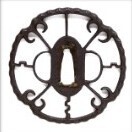Interesting, comments about this kozuka
Ko-Kinkou-style, Kurikara Ryu Zu
The surface of this Kozuka is decorated with the Nanako-Ji (魚子地) technique. It is made by hitting the Nanako-Ji Tagane (魚子地鏨, chisel used for this technique). Although the surface is worn down due to aging, you could see delicate fish egg-shaped protrusions.
About the design, you see a dragon that coils its body around the blade. This motif is called the Kurikara-Ken (倶利伽羅剣), which is the sword that Fudo Myo-O (不動明王, acalanātha) holds with his right hand. Fudo Myo-O is one of the objects of worship in Buddhism. According to a theory, it is the incarnation of Dainichi Nyorai (大日如来, Mahāvairocana, the principal image of esoteric Buddhism). The Kurikara-Ken was named after its appearance that Kurikara Ryu-O (倶利伽羅龍王, dragon) is winding around the sword. It is believed that the Kurikara-Ken could cut off worldly desires: Sandoku (三毒). Sandoku is the three fundamental human desires; Ton (貪, greed), Jin (瞋, anger, grudge), Chi (癡, delusion, complaint). The handle part of this blade looks like the Sankosho (三鈷杵, a type of item of esoteric Buddhism).
This Kozuka is recognized by The Society for the Preservation of Japanese Art Swords, which is known as NBTHK.


